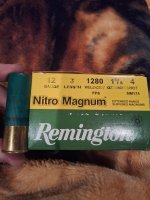Glock
Well-known member
I just got done reading and article from pheasant forever and it discussed late season strategies. Most was common knowledge but one stuck out at me. He was discussing his gun and what he used. It was an over/under. He went on to say his favorite shells were #5 bismuth and #4 lead. But what caught my attention was that he said in one barrel he used a skeet choke and the other an improved. I was a little surprised by that considering the topic was late season. What do you all use? Follow up with that answer with telling me your typical shooting distance for late season.

